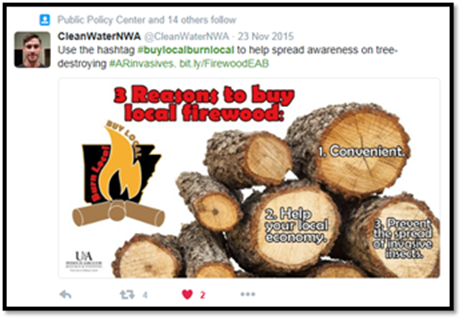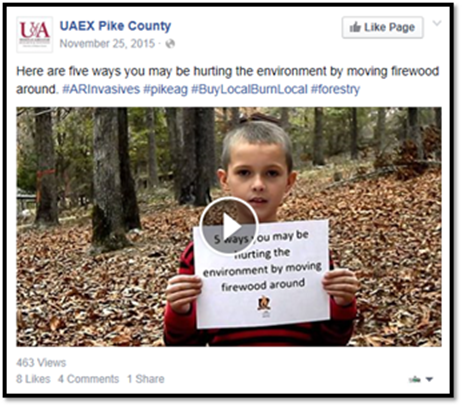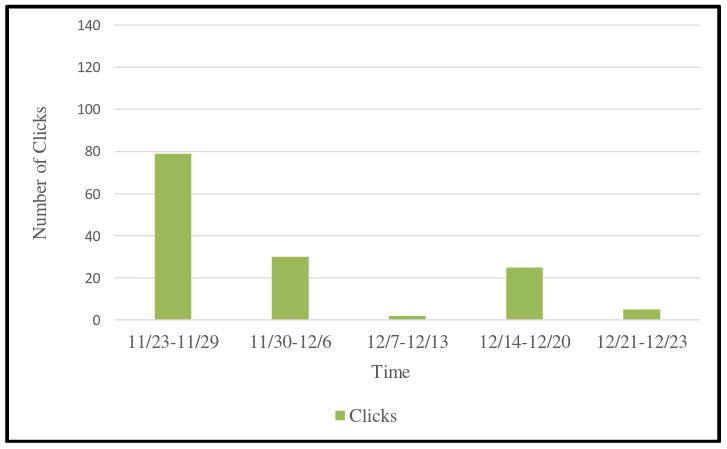 |
April 2017
|
April 2017 // Volume 55 // Number 2 // Ideas at Work // v55-2iw6
A Practical Method for Collecting Social Media Campaign Metrics
Abstract
Today's Extension professionals are tasked with more work and fewer resources. Integrating social media campaigns into outreach efforts can be an efficient way to meet work demands. If resources go toward social media, a practical method for collecting metrics is needed. Collecting metrics adds one more task to the workloads of Extension professionals and their partners. Can metrics be collected in an efficient and effective long-term manner even when partners are involved? We propose a practical method for collecting social media communication campaign metrics that is easy to implement and allows for measuring engagement of users over time.
Introduction
Over 70% of online adults use Facebook, and more than 50% of online adults use two or more social media sites (Duggan, Ellison, Lampe, Lenhart, & Madden, 2015). Given the popularity of social media and its benefits, which include access to a wide audience, opportunities to communicate quickly and inexpensively with stakeholders, and opportunities for educators and stakeholders to work together (Newbury, Humphreys, & Fuess, 2014), it is not surprising to see increased interest in and use of social media by Extension professionals. Numerous articles have focused on how social media applications can be integrated into Extension work (Christensen, Hill, & Horrocks, 2015; Cornelisse et al., 2011; Gharis, Bardon, Evans, Hubbard & Taylor, 2014; Kinsey, 2010; Typhina, Bardon, & Gharis, 2015). As more Extension professionals seek to integrate social media use into their daily work, measuring impacts becomes more important.
Identifying a Need and Developing a Method
Communication professionals at the University of Arkansas System Division of Agriculture frequently partner with county Extension agents to more efficiently move messages throughout the state. Realizing that partners are stretched for time and resources, we worked with a team of communication professionals within the University of Arkansas System Division of Agriculture to develop a practical method for collecting metrics on regularly implemented social media communication campaigns. We determined that the method had to be easy to implement and had to measure engagement by users. On the basis of previous findings (Doyle & Briggeman, 2014; Gharis et al., 2014; O'Neill, 2014), we considered the following measurements:
- engagement (clicks, likes, shares, comments),
- message movement (clicks, impressions, and views over time),
- conversation index (ratio of number of comments received to number of posts), and
- influence of the messenger (Klout scores).
With these requirements and measurements in mind, we developed and proposed a method for practically collecting campaign metrics. The steps of our method were as follows:
- Develop specific communication materials with unique hashtags and shortened URLs (e.g., bit.ly, TinyURL, and goo.gl), which can be easily tracked.
- Share communication materials with partners and encourage them to move the messages across specific media platforms over a set time period.
- Communicate the same messages across our own platforms over the set time period.
- Collect social media campaign metrics (posts, clicks, likes, retweets/shares, comments, engagement, impressions, views, and Klout scores) to measure engagement of users, message movement, conversation index, and influence of messenger over a set period of time.
Developing and Implementing an Applicable Communication Campaign
To test the practicality of the proposed method, we developed and implemented a communication campaign. The campaign was titled "Buy Local, Burn Local" and applied reasons for buying local produce and products to buying and burning local wood. Communication materials included unique hashtags and shortened URLs for ease of tracking.
Communication materials were given to Arkansas county agents and staff chair partners in fall 2015. These partners were encouraged to share the developed messages across their media platforms from November 23 through December 23, 2015. In addition to sharing the communication messages via Facebook and Twitter, partners were asked to sign up for a free Klout account and to track metrics from their social media posts. We communicated that we would give a $25 gift card to the agent or staff chair partner who had the greatest influence. Example messages developed by our team and shared by partners can be seen in Figures 1 and 2.
Figure 1.
Shared Twitter Message from "Buy Local, Burn Local" Campaign
Figure 2.
Shared Facebook Message from "Buy Local, Burn Local" Campaign
During the same time period as our partners, we used our own Facebook and Twitter platforms to share the developed messages. After the communication campaign, we requested the following metrics from our partners: social media platforms used, posts, likes, retweets/shares, engagement, comments, impressions, views, clicks, and change in Klout scores.
Results and Discussion
Although we asked our partners to provide us with full sets of campaign metrics, we did not receive complete data sets from all partners participating in the campaign. Therefore, we collected our own metrics by tracking the unique hashtags and shortened URLs and by reviewing Facebook and Twitter analytics on our own personal and business social media accounts. Table 1 shows the tracked metrics, which can be used to demonstrate engagement and to calculate the conversation index.
| Media/metric | Posts | Clicks | Likes | Retweets/shares | Comments | Engagement | Impressions | Views |
| 77 | 141 | 38 | 83 | 342 | 22,592 | |||
| 8 | 34 | 11 | 5 | 1,694 | ||||
| Total | 85 | 141 | 72 | 94 | 5 | 342 | 22,592 | 1,694 |
| Average | 1.83 | 0.85 | 1.11 | 0.63a | 4.44 | 293.40 | 211.75 | |
| aFacebook conversation index: ratio of number of comments received to number of posts. | ||||||||
Twitter defines "engagement" as the number of times a user interacts with a tweet and "impressions" as the number of times a user sees a post on Twitter, whereas Facebook defines "views" as the number of times a page is viewed. Note that we have more broadly defined engagement as clicks, likes, shares, and comments in this article to more fully include engagement from multiple social media platforms.
Figures 3 and 4 display data indicating message movement over time, obtained by tracking impressions, views, and clicks by week throughout the campaign. Note that the final week was only 3 days.
Figure 3.
Impressions and Views by Week Throughout the "Buy Local, Burn Local" Campaign

Figure 4.
Number of Clicks by Week Throughout the "Buy Local, Burn Local" Campaign

We aimed to develop a practical method for collecting social media campaign metrics. Although our proposed method included measuring the influence of the messenger, we were not able to track this metric without feedback from each of the partners. With the knowledge that we benefit from working with partners to communicate via social media and that we want to track metrics as efficiently as possible, we suggest removing Klout scores from the proposed method. Without Klout scores, the proposed method for collecting social media campaign metrics is a practical method, especially when partners are involved.
Conclusion
As Extension professionals work together to enhance outreach, metrics collection methods can become more challenging. The proposed method takes into consideration time constraints of partnering entities. Use of the method involves only asking that partnering entities share material rather than adding metrics collection to the list of tasks required of them. Metrics collection is left to the Extension professional leading the communication effort. This method should allow for not only more cooperation but also more efficient and effective measurement of social media efforts over time.
References
Christensen, A., Hill, P., & Horrocks, S. (2015). The social media marketing map (Part 1): A tool to empower the digital leaders of Extension. Journal of Extension, 53(4), Article 4TOT3. Available at: https://www.joe.org/joe/2015august/tt3.php
Cornelisse, S., Hyde, J., Raines, C., Kelley, K., Ollendyke, D., & Remcheck, J. (2011). Entrepreneurial Extension conducted via social media. Journal of Extension, 49(6), Article 6TOT1. Available at: https://www.joe.org/joe/2011december/tt1.php
Doyle, M., & Briggeman, B. (2014). To like or not to like: Social media as a marketing tool. Journal of Extension, 52(3), Article 3IAW1. Available at: https://www.joe.org/joe/2014june/iw1.php
Duggan, M., Ellison, N., Lampe, C., Lenhart, A., & Madden, M. (2015). Social media update 2014. Pew Research Center. Retrieved from http://www.pewinternet.org/2015/01/09/social-media-update-2014/
Gharis, L., Bardon, R., Evans, J., Hubbard, W., & Taylor, E. (2014). Expanding the reach of Extension through social media. Journal of Extension, 52(3), Article 3FEA3. Available at: https://www.joe.org/joe/2014june/a3.php
Kinsey, J. (2010). Five social media tools for the Extension toolbox. Journal of Extension, 48(5), Article 5TOT7. Available at: https://www.joe.org/joe/2010october/tt7.php
Newbury, E., Humphreys, L., & Fuess, L. (2014). Over the hurdles: Barriers to social media use in Extension offices. Journal of Extension, 52(5), Article 5FEA1. Available at: https://www.joe.org/joe/2014october/a1.php
O'Neill, B. (2014). Evaluating the impact of Cooperative Extension outreach via Twitter. Journal of Extension, 52(5), Article 5TOT1. Available at: https://www.joe.org/joe/2014october/tt1.php
Typhina, E., Bardon, R., & Gharis, L. (2015). Collaborating with your clients using social media & mobile communications. Journal of Extension, 53(1), Article 1TOT2. Available at: https://www.joe.org/joe/2015february/tt2.php




